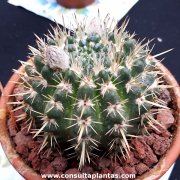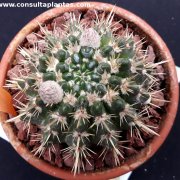Care of the cacti Parodia mammulosa or Tom Thumb |
|
The genus Parodia, family Cactaceae, includes about 50 species of cacti native to South America. Some species are: Parodia mammulosa, Parodia magnifica, Parodia leninghausii, Parodia haselbergii, Parodia concinna, Parodia werneri, Parodia nivosa, Parodia ottonis, Parodia penicillata. Common names: Tom Thumb, Lemon Ball. Scientific synonyms: Echinocactus mammulosus, Ritterocactus mammulosus, Malacocarpus mammulosus, Notocactus mammulosus. This species is native to Rio Grande Do Sul, Brazil. They are small cacti with a globose body of dark grayish green color that reach 10 cm (3.93") in height. They have 18-20 tuberculate ribs, 10-13 yellowish radial spines and 3 central spines 1.5 cm (0.59") long, yellow with a brown tip; at the apex of the plant they do not present thorns. The attractive yellow flowers are up to 4 cm (1.57") in length. Very young plants can bloom. Due to its small size Tom Thumb is used in pots as terrace, balcony and window plants and as indoor or greenhouse plants in well ventilated locations. Parodia mammulosa needs full sun exposure and warm weather. It does not resist temperatures below 4 ºC (39.2 ºF). The soil can be a mixture of 1/3 volcanic gravel, 1/3 blond peat and 1/3 topsoil or a commercial cactus substrate with a little organic matter and volcanic gravel. The transplant is done in early spring. Water regularly in spring and summer, waiting for the substrate to dry. Reduce watering in fall and do not water in winter. Fertilize in mid-spring with mineral cactus fertilizer. Tom Thumb does not need pruning. Parodia mammulosa is a resistant plant to the habitual plagues and diseases but sensitive to the excess of irrigation. Lemon Ball is easily propagated from seed sown in spring. |
Images of the cacti Parodia mammulosa or Tom Thumb |
Find plants
Parodia mammulosa or Tom Thumb | Care and Growing
© 2026 FavThemes

